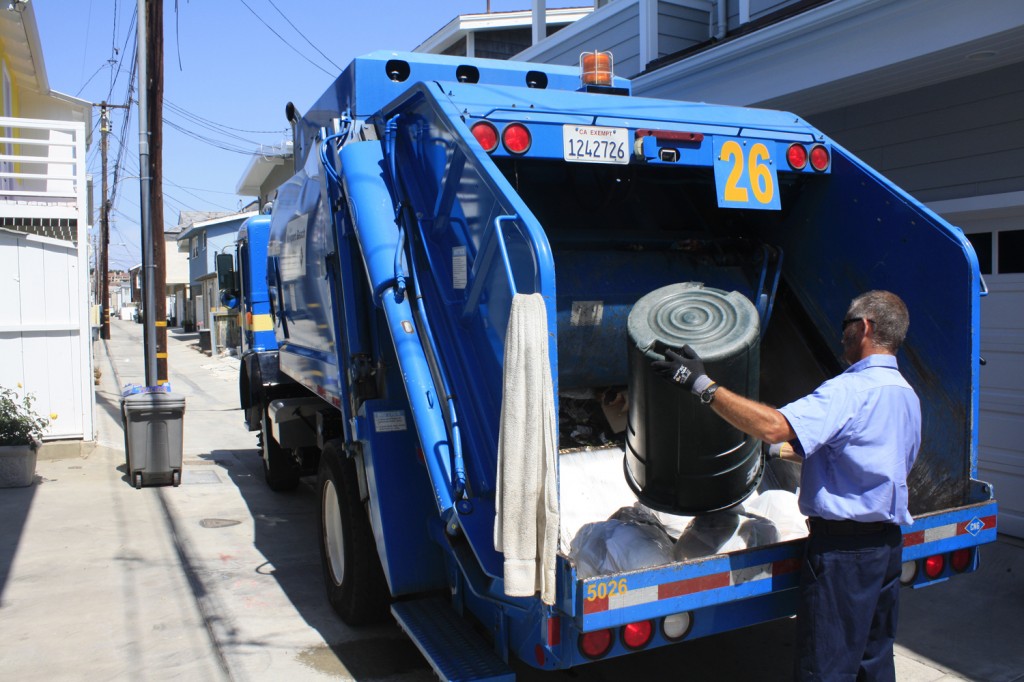
— Photo by Christopher Trela ©
Trash was the topic on the table during a recent community discussion, specifically organic waste collection and how the city can comply with some upcoming changes to the law.
About 70 people attended the meeting, held April 11 in the community room at the Newport Beach Civic Center. The meeting was titled “Are the trash police coming to your house?”
There are “major changes” coming to Newport Beach about organic waste recycling, Speak Up officials commented. New state laws mandate that Newport Beach enact stricter trash collection procedures, including strict enforcement.
There is a lot to consider on this topic and the upcoming changes, noted Newport Beach Public Works Director Dave Webb.
“You would think it’s a simple subject…no it’s not, it’s very complex,” Webb said.
This is one of the highest regulated industries in the world, and it gets very complicated, added Dean Ruffridge, senior vice president of CR&R, the company who manages the residential waste collection in the city.
There is an education component, Webb noted, which includes public forums like Speak Up Newport, in an effort to inform and collect input from the community.
In order to comply with the laws, there also has to be monitoring of possible contamination via on-site inspections, conducting targeted education, and program enforcement, Webb added. This is what is referred to as “garbage police,” Webb added.
“This is really where we’re focusing right now, how are we going to address this?” Webb asked. “We may have to change the way we collect our refuse.”
It wasn’t too long ago that all garbage was collected and dumped, or some people burned it at home, Webb noted. That led to a number of problems, including running out of space and pollution, he added.
“We had mounds and mounds of garbage,” Webb said, so, the government stepped in and passed some major laws.
At the state level, between 1989 and 2016, California has put five major overriding laws place to reduce material going into landfills, promote or require recycling and reuse, and reduce greenhouse gas from landfills, Webb explained.
Now, they’re starting to look at organic waste.
Organic waste includes food waste, landscape trimmings, non-hazardous wood waste, and compostable paper. Overall, organic waste and compostable paper makes up about 41 percent of all disposed waste in California, according to 2014 records.
“So, we’ve got a big slug that’s going to the landfill that’s just organic material,” Webb said.
AB 1826 requires local jurisdictions to implement an organic waste recycling program for businesses and multi-family dwellings of five or more units.
The commercial organics recycling has a compliance level goal of 50 percent reduction in organics disposal by 2020. There was a 28 percent compliance rate in 2018, Webb reported, which is good compared to some other jurisdictions.
“So, we are on our way to that, but that’s part of the discussion we’re starting to have,” Webb said.
AB 1594 mandates that, as of Jan. 1, 2020, the use of green material as an “alternative daily cover” will no longer constitute diversion through recycling and will instead be considered disposal, in terms of measuring a jurisdiction’s annual 50 percent per capital disposal rate.
Previously, covering waste up with green material worked well, Webb said, it reduced the smell and the number of animals scavenging.
“It creates a big problem for us, we have to do something else with that organic material,” Webb said.
Currently, the green waste that collectors pick out of the residential trash goes to alternative daily cover, Ruffridge explained. It’s pretty dirty, he added, sometimes with pieces of glass or plastic in it that can’t be composted.
As of the end of this year, a decision has to be made about how organics are collected at the curbside, Ruffridge said.
SB 1383, the short-live climate pollutants law, requires a 50 percent reduction in the level of statewide disposal of organic waste (as compared to the 2014 numbers) by 2020. Going even further, that figure needs to be up to 75 percent reduction by 2025.
It also requires a 20 percent improvement in edible food recovery by 2025. It’s a good cause to try and get the food to people who need it will eat it, but, logistically, it’s a challenge.
Nearly 20 percent of people in Orange County go to bed hungry, Ruffridge said.
“There are a lot of people in Orange County that are hungry and need food,” he said.
There is lot of edible food that goes to waste, Ruffridge said.
CR&R has partnered with several nonprofits in the county to collect that food, including from restaurants and grocery stores, and distribute it every day.
People want to know, “What about at my home?” Ruffridge said.
There is a four-cart system that addresses that, he noted, specifically for organic food material.
Webb also went over the cart options for residential organics collection, which vary between two to four carts for the different materials.
A wet/dry system would just take the two carts Newport Beach residents currently use and separate the material a little differently. The three-cart system would be slightly expanded on that idea with two dry carts, one for recyclable and one for non-recyclable, and one cart for wet organic materials. The four-cart system, which the audience laughed when it was mentioned (maybe not for Newport, Webb responded), would be expanded even more with two carts for dry materials, one recyclable and one non-recyclable, one cart for wet organic materials, and one cart for organic food materials.
There are also several different processing methods for dealing with organic material, including composting, anaerobic digestion, and co-digestion, Webb explained.
They are currently considering the different options, which should be considered by City Council soon, Webb noted.




